Farmers Field Environmental Impact Report Omits Toxic Perchlorate Fireworks Usage
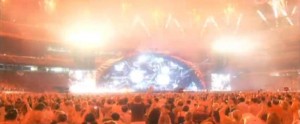
* Perchlorate use and quantities not reported in $27 million AEG environmental report
* AEG and city reject use of ‘greener’ fireworks used by Disney and shared royalty-free
* Recent study shows huge increase in persistent long-lasting perchlorate after fireworks shows
* Faulty EIR may open city and AEG to lawsuits
The Los Angeles City Planning Commission approved late yesterday the final environmental impact report for the $1.2 billion Farmers Field downtown on 68 acres of city-owned land. It was the second to last hurdle for developer, the Anschutz Entertainment Group (AEG).
“We’re going to have a state of the art green stadium,” said planning commissioner Sean Burton before putting the matter to a vote after effusive praise of planning staff for completing the massive environmental impact report. The EIR is made up of a draft report (DEIR) and a final report(FEIR) combined together. The EIR is paid for and produced by the applicant AEG.
The planning commission’s unanimous authorization will bring AEG closer to the expected approval of the city council September 28, a process fast-tracked to help AEG acquire a professional football team by early next year to begin playing in the new stadium in 2017.
City Councilmember Jan Perry sought and got the public hearing notice period for the FEIR to be just 10 days instead of 24 after yesterday’s yes-vote. Now the city council will take its final vote on the project September 28.
Strong objections to this shortened period for public comment on the project next to the Staples Center were to avail. Community activists said that lessened analysis and comment period could burden poor neighborhoods adjacent to the site. Supporters, however, say Farmers Field will bring jobs to the community, increase L.A.’s tax base and bring back pro football, the Super Bowl and even the Final Four to the second largest city in the nation.
Local media has swooned over the project and its open-roofed venue with graceful wing-like translucent outdoor concourses. Two recent Los Angeles Times‘ editorials managed to praise the project while all but calling the community representatives extortionists.
“There is still, however, a coalition of community groups pushing for further environmental and other concessions, a fight they say they will pursue with the city’s elected leadership and, if that fails, in court,” Jim Newton wrote in a September 10 op-ed piece. “The coalition won’t get all it’s asking for. It shouldn’t.”
The community groups Newton dismissed as mere pests included the Los Angeles Community Action Network, the Legal Aid Foundation of Los Angeles (LAFLA), and the Nobel Peace Prize-winning Physicians for Social Responsibility (PSR-LA) who are part of the Play Fair Farmers Field Coalition. The non-profit organizations are not opposing the stadium, rather they are fighting to reduce the health impacts on surrounding neighborhoods from the project.
These environmental threats include diesel and gasoline fumes from the thousands of cars that may end up idling on streets around Farmers Field for lack of parking – AEG’s plan counts on 27 percent of the people coming to the stadium taking mass transit. Activists question this assumption, and contend the project will put a premium on land surrounding the site to be built out as new parking as the congestion increases the demand for more land for parking. They also say that in the rush to approve the massive construction, which will include tearing down the Los Angeles Convention Center and replacing it, environmental considerations will be missed or ignored entirely.
“The project’s developer, AEG, in return for being granted a special exemption from state environmental laws, has pledged to build the nation’s greenest football stadium that will be an engine of opportunity for working families in our city,” said LAFLA’s Staff Attorney for Community Economic Development, Zahirah Mann in a statement May 30 regarding the group’s DEIR comments on behalf of the Play Fair at Farmers Field Coalition. “Our action today is an important step to holding AEG to that promise.”
Information uncovered in the last week however suggests new hurdles.
THE ROCKETS’ RED GLARE
EnviroReporter.com has discovered that the Farmers Field environmental reports fail to account accurately for all the toxins in planned fireworks displays including the oxidizer perchlorate which is common to most fireworks as a main ingredient. We have also discovered that two the four heavy metals listed in the EIR as the fireworks’ ingredients, both toxic, are listed with quantities that are erroneous. In addition, AEG maintains there are no ways to mitigate its fireworks – but lower-emission fireworks options are in fact readily available.
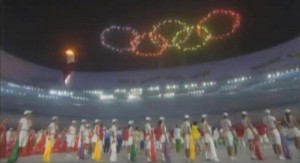
Regardless, the EIR does address the risk from fireworks not by analyzing how much perchlorate will be blown off in the stadium but by comparing the explosions to the total emissions of the project. “[P]otential emissions from fireworks would represent less than 0.1 percent of potential Project-related emissions and would occur on a limited number of days per year,” the EIR reads in response to a public comment. “However, in response to this comment, the health risk assessment has been updated to include air toxic emissions from fireworks.”
The included air toxic emissions from fireworks did not include the perchlorate which is common to most fireworks, including “green fireworks,” as well as the traditional chemical makeups for the bursts like the ones Farmers Field will be using.
In response to public comments on the DEIR submitted by LAFLA regarding the use of perchlorate and heavy metals in the fireworks, AEG countered – without explanation – by reducing the number of dedicated fireworks shows yearly by nearly 60%. But if the fireworks aren’t packing anything toxic like perchlorate, it doesn’t follow that the company would have to reduce its shows.
In regards to so-called low emissions fireworks usage, which swap out the gunpowder propellant with a compressed air launch system, the company has agreed to use such technology as an option but not a requirement. “Lower emissions fireworks shall be used to the extent feasible for ‘proximate fireworks’ where it would achieve a similar fireworks effect.” In other words, traditional fireworks can and will be used.
Depending on which way the wind is blowing, smoke from the fireworks could blow on the predominate breeze from the west into the tony confines of South Park condos which would have a view, and a nose, for the stadium cost a cool million or more. When the wind reverses in Santa Ana conditions, fireworks smoke would blow into the working class and immigrant community of the Pico Union neighborhood.
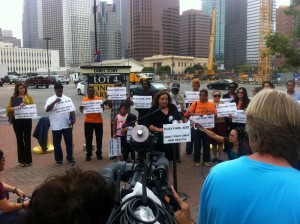 “It seems like one of the things that’s lacking is fully documenting the extent of the problem and then say whether they can or cannot mitigate the problem,” Martha Dina Argüello, executive director of PSR-LA, told EnviroReporter.com. “I think it lacking specific numbers on the [fireworks] emissions is a problem and not telling us what is actually in the fireworks is a problem.”
“It seems like one of the things that’s lacking is fully documenting the extent of the problem and then say whether they can or cannot mitigate the problem,” Martha Dina Argüello, executive director of PSR-LA, told EnviroReporter.com. “I think it lacking specific numbers on the [fireworks] emissions is a problem and not telling us what is actually in the fireworks is a problem.”
Perchlorate has negatively impacted at least 27 states according to the EPA, none more so than California where the chemical has been used extensively. Perchlorate is heavily regulated in California and its usage, handling and storage must be reported to the government.
“Perchlorate and its salts are used in solid propellant for rockets, missiles, and fireworks, and elsewhere (e.g., production of matches, flares, pyrotechnics, ordnance, and explosives). Their use can lead to releases of perchlorate into the environment,” says the California Department of Public Health (CDPH).
“Perchlorate’s interference with iodide uptake by the thyroid gland can decrease production of thyroid hormones, which are needed for prenatal and postnatal growth and development, as well as for normal metabolism and mental function in the adult,” CDPH states in its “Health Concerns” section on perchlorate. “Its effects on the thyroid gland are the basis of the 6-µg/L public health goal (PHG) established in 2004 by Cal/EPA’s Office of Environmental Health Hazard Assessment,” which is equivalent to 6 parts per billion (ppb).
 Such is the public health concern over perchlorate that the U.S. Environmental Protection Agency (EPA) has decided to regulate the chemical under the Safe Drinking Water. California EPA’s Department of Toxic Substances Control (DTSC), the department charged with enforcing toxic chemicals, has attempted robust state regulation of perchlorate.
Such is the public health concern over perchlorate that the U.S. Environmental Protection Agency (EPA) has decided to regulate the chemical under the Safe Drinking Water. California EPA’s Department of Toxic Substances Control (DTSC), the department charged with enforcing toxic chemicals, has attempted robust state regulation of perchlorate.
“Perchlorate is becoming a serious threat to human health and water resources,” says DTSC on its perchlorate portal page on its website. “In addition to overseeing the cleanup of sites contaminated with perchlorate, AB 826, the Perchlorate Contamination Prevention Act of 2003, required DTSC to adopt regulations specifying best management practices for perchlorate and perchlorate-containing substances. The Perchlorate Best Management Practices were adopted on December 31, 2005 and became operative on July 1, 2006.”
Yet despite the known threats that perchlorate presents, AEG’s EIR never admits it usage in the fireworks that stadium operators are going to be blasting off in the new Farmers Field. Not only is the perchlorate usage obscured in the EIR, it isn’t weighed up as toxins traditionally are in environmental impact reports, usually in pounds per day and pounds per year.
“It’s important for us to look at perchlorate emissions from fireworks,” says Joe Lyou, head of the Los Angeles-based Coalition for Clean Air in a telephone interview with EnviroReporter.com. “We know that it’s a source for perchlorate. We know that perchlorate has been found to cause public health problems so certainly AEG has not analyzed perchlorate emissions in fireworks. They need to do so.”
HEAVY METAL THUNDER
EnviroReporter.com has also discovered that the only fireworks ingredients that are listed in the EIR are the heavy metal contaminants that are used to color the fireworks: strontium (red), barium (green), copper (blue) and antimony (white and glitter effects). Yet even the numbers for these toxins are suspect: the EIR’s figures for the ‘per day’ and ‘per year’ usage for copper and antimony, respectively, are the same.
Either the EIR is incorrect or Farmers Field plans to only have blue fireworks and white fireworks with glitter effects just one day a year which is highly unlikely. More likely is that the calculations are incorrect. This seems surprising considering the 18 months AEG took to create its $27 million EIR that totals at least 14,759 pages.
“You’ve got to at least have all the primary colors to get to the other colors you use in fireworks,” says Argüello. “I can’t imagine a show that would only use red or only going to use yellow.”
EnviroReporter.com has contacted AEG and provided a requested email outlining questions concerning the fireworks. AEG will be responding to our inquiries according to the company rep. A list of EnviroReporter.com‘s questions about the missing information concerning the pyrotechnics was also submitted to the Los Angeles Planning Commission before its meeting.
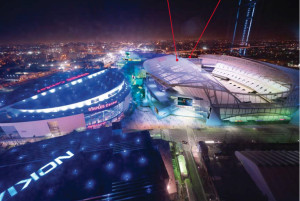 Farmers Field will be allowed to shoot off fireworks 365 days a year at the stadium from 10:00am to 11:30pm. There will be 15 dedicated fireworks shows a year lasting up to 20 minutes long like on July 4. Other fireworks may accompany the national anthem, football touchdowns or rock concerts like the May 8 video rendering on Farmers Field’s YouTube channel shows. A virtual crowd watches a rock show as fireworks in the video explode around the edge of the giant oval opening in massive blasts above the stadium filling it with smoke.
Farmers Field will be allowed to shoot off fireworks 365 days a year at the stadium from 10:00am to 11:30pm. There will be 15 dedicated fireworks shows a year lasting up to 20 minutes long like on July 4. Other fireworks may accompany the national anthem, football touchdowns or rock concerts like the May 8 video rendering on Farmers Field’s YouTube channel shows. A virtual crowd watches a rock show as fireworks in the video explode around the edge of the giant oval opening in massive blasts above the stadium filling it with smoke.
Color-creating heavy metals revealed to be in the Farmers Field fireworks can impact human health and the environment as well as perchlorate. Barium nitrate, added to fireworks to create that green color, is toxic according to Hazard.com, which says ingestion of the heavy metal “May cause tightness of the muscles of the face and neck, vomiting, diarrhea, abdominal pain, muscular tremors, anxiety, weakness, labored breathing, cardiac irregularity, convulsions, and death from cardiac and respiratory failure.”
Inhalation of barium, according to Hazard.com, “Causes irritation to the respiratory tract. Symptoms may include coughing, shortness of breath. Systemic poisoning may occur with symptoms similar to those of ingestion.”
One commenter on the project voiced concern about cadmium in the fireworks. “Used to produce a wide range of fireworks colors, [cadmium] is also a known human carcinogen,” the commenter wrote. “Breathing high levels of cadmium can seriously damage the lungs, and consuming it can fluster the stomach, often resulting in vomiting and diarrhea. Long-term exposure can lead to kidney disease, lung damage and fragile bones. Plants, fish and other animals take up cadmium from the environment, meaning that any released into waterways from a fireworks show can be passed up the food chain.”
The closest waterway to the future Farmers Field is the Los Angeles River, a little over two miles to the east. The waterway was recently reaffirmed as being protected by the Clean Water Act.
Copper compounds are used to produce blue colors, even though they produce dioxin, which has been linked to cancer according to a 1999 study by Dr. Robertus Vichman of Braunschweig Technical University in Germany. According to the report, the intense heat generated by the perchlorate in fireworks ignites copper coloring compounds giving off significant amounts of dioxin.
Perchlorate’s use in Farmers Field is particularly troubling not just because its use is obscured and not measured in the EIR let alone mitigated; the chemical has wreaked havoc across California in both its ammonium perchlorate and potassium perchlorate forms. While it’s likely that the potassium perchlorate compound is going to be used in Farmers Field, the EIR’s failure to identify and quantify the amount of perchlorate to be ignited doesn’t provide the opportunity to distinguish the effects of which perchlorate to be utilized.
Regardless, perchlorate’s affects locally, regionally and statewide have been significant. As EnviroReporter.com has previously reported in 2005, perchlorate has polluted more than 330 drinking water sources in California where concentrations of the toxin have exceeded the state’s provisional action-reporting level of 6 ppb. That number has climbed to over 350 now according to the EPA’s Region 9 office which oversees the state.
The San Gabriel Valley is an EPA Superfund Site which is a designation for some of the most contaminated locations in the country. Shorthand for the Comprehensive Environmental Response, Compensation, and Liability Act of 1980, Superfund gives wide federal powers to clean up contamination or anticipated hazardous substances at sites and charge the responsible party or parties for the cost. If the responsible party can’t be found, EPA has a special Superfund trust fund to pay for the cleanup.
At least 23 drinking water wells have been contaminated with perchlorate in the San Gabriel Valley, most of which are situated in the Azusa and Baldwin Park area. The first system to clean up the perchlorate was installed in 2001 with four currently in place. These ion exchange technology-driven systems cost more than $17 million to construct and cost about $5 million a year to operate. By 2024, EPA estimates that the cost of cleaning perchlorate out of the San Gabriel Valley groundwater is staggering – more than $200 million to clean the groundwater of perchlorate and other contaminants just at the Baldwin Park water remediation station alone.
ON BARSTOWED TIME
Over 40,000 people of the Mojave Desert town of Barstow learned about perchlorate the hard way in November 2011. The town, which is exactly midway between Los Angeles and Las Vegas, suddenly became aware of a perchlorate contamination plume that had first been detected from a test on the Soap Mine Road Well which had high perchlorate. For days thousands of people were forced to queue up in long lines for hours to get drinking water that was being hauled into the city on an emergency basis because a number of wells in town used for potable water were testing higher than California’s drinking water limit of 6 ppb for perchlorate.
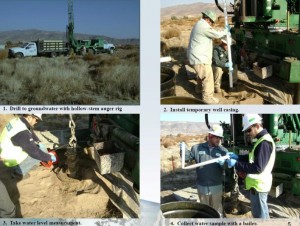 Investigators for the Lahontan Regional Water Quality Control Board found the source of the perchlorate about a mile away at the private home of a long-deceased man who used to own the Mojave River Pyrotechnics Company. Apparently, after his company went bankrupt in the 1980s, the man buried much of the leftover perchlorate in his back yard on Poplar Lane near the usually dry wash that is the Mojave River.
Investigators for the Lahontan Regional Water Quality Control Board found the source of the perchlorate about a mile away at the private home of a long-deceased man who used to own the Mojave River Pyrotechnics Company. Apparently, after his company went bankrupt in the 1980s, the man buried much of the leftover perchlorate in his back yard on Poplar Lane near the usually dry wash that is the Mojave River.
Perchlorate, which is very mobile and persistent in nature, was eventually mapped out underground with the majority of the goo within an area about 1,400 feet wide and 3,500 feet long. Groundwater, obviously a precious commodity in the desert, was found with perchlorate as high as 110,000 ppb or over 18,000 times the California’s perchlorate drinking water standard. Soil came in at more than 500,000 ppb in the worst hit dumps on the property.
Just cleaning up the soil will cost millions according to the EPA. The groundwater remediation would be a much greater challenge and take far longer.
WAR FACTORIES
Perchlorate is also used in missile fuel as an oxidizer and, just like in fireworks, burns fast and hot. That legacy has left aerospace-related sites like Aerojet Chino Hills massively contaminated with the toxin. When LA Weekly exposed perchlorate pollution at the facility in May 2000 followed by OC Weekly, it helped precipitate $46 million worth of cleanup. The property still isn’t fully free of perchlorate, depleted uranium and unexploded ordnance debris and remains a sore spot with a number of residents in the region.
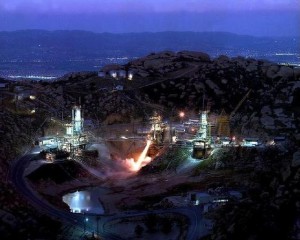 Closer to Los Angeles 35 northwest of downtown is the Santa Susana Field Laboratory which, besides being infamous for being the site of the country’s worst partial nuclear meltdown in 1959, is polluted by perchlorate. Over 30,000 rocket test took place at the 2,850-acre aerospace complex which had gigantic rocket test stands, many of which are still standing today amidst land impacted by perchlorate.
Closer to Los Angeles 35 northwest of downtown is the Santa Susana Field Laboratory which, besides being infamous for being the site of the country’s worst partial nuclear meltdown in 1959, is polluted by perchlorate. Over 30,000 rocket test took place at the 2,850-acre aerospace complex which had gigantic rocket test stands, many of which are still standing today amidst land impacted by perchlorate.
The perchlorate in the fuel fired off testing rockets like the Atlas, Thor and Saturn, left the test stands, buildings, land and groundwater highly contaminated. In 2004, data showed perchlorate in Building 359, on the property now owned by Boeing, as having 34 of 90 samples contaminated with perchlorate so high that they all exceeded “field action levels” where immediate action is mandatory. One sample came back positive for 71,290 ppb of perchlorate.
Perchlorate is a chemical of concern for many Southern Californians because of its widespread fouling of the environment and its effects on the development of the very young and young. These illustrations point to the seriousness of the chemical, especially when large amounts of it are being used in a semi-enclosed space for optional spectacle.
A decade-long struggle over developing Ahmanson Ranch began coming to a head in 2002. There on land bordering Rocketdyne’s southern buffer zone, now-defunct Washington Mutual was on its way to building 3,050 homes in a huge $2 billion development until media pressure forced the company to test its groundwater. “WaMu” had planned to use 660,000 gallons of the groundwater each day to irrigate it common areas, parks and playgrounds.
When one of the wells came back positive with 28 ppb of perchlorate, and Rocketdyne Ranch exposed that and other contamination problems with the property, the public outcry grew and the company begrudgingly accepted an offer of $150 million to give the land to the state which turned it into the Upper Las Virgenes Open Space Preserve. It is the largest single public acquisition of land in the history of both Ventura and Los Angeles counties.
SMOKE ON THE WATER
A May 2007 study by the EPA’s Office of Research and Development, National Risk Management Research Laboratory in Oklahoma City made the danger of perchlorate in fireworks abundantly clear. “Perchlorate Behavior in a Municipal Lake Following Fireworks Displays” showed that after a fireworks show, the lake’s water had 24 to 1,028 times the baseline amount of perchlorate. It took 20 to 80 days for the perchlorate concentrations to return to background.
That the perchlorate usage is not listed in the Farmers Field EIR, let alone admitted to, creates another challenge in the EIR: mitigation. Without acknowledging the perchlorate-based fireworks, there can be no discussion of how to mitigate them. Indeed, the EIR says as much.
“There are no feasible mitigation measures that would reduce impacts associated with the parking garage and firework displays to a less than significant level,” the DEIR stated. “Impacts related to fireworks displays would be limited (up to 35 shows per year) and of short duration (up to 20 minutes per display show) but would still be significant and unavoidable.”
Activists say that AEG should have considered going greener with Farmers Field fireworks. “Fortunately, there is a better way to mitigate the amounts you use with ‘green fireworks’ or the lower-emission fireworks,” says Argüello. “That technology is readily available from Disney, as I understand, and that’s what they use. They do very elaborate close to ground level fireworks everyday so they’ve developed where you’re using a lot less of the propellant to get the fireworks into the air which is where a lot of those emissions come from.”
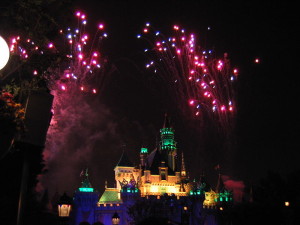 Disneyland holds fireworks shows over 230 nights of the year. Responding to numerous complaints since 1991 to the South Coast Air Quality Management District citing ash, smoke, smell and property damage from falling firecracker shells, Disney switched to compressed air in 2004 to shoot up about 350 shells used per show. By removing the gunpowder propellant, much of the smoke that clouds traditional fireworks shows doesn’t exist making the flashes and pyrotechnics brighter.
Disneyland holds fireworks shows over 230 nights of the year. Responding to numerous complaints since 1991 to the South Coast Air Quality Management District citing ash, smoke, smell and property damage from falling firecracker shells, Disney switched to compressed air in 2004 to shoot up about 350 shells used per show. By removing the gunpowder propellant, much of the smoke that clouds traditional fireworks shows doesn’t exist making the flashes and pyrotechnics brighter.
In its first year alone, Disney ditched 30,000 pounds of the 90,000 pounds it used in 2003, a significant reduction of a third. The company has offered the use of its compressed-air launch design system to other fireworks-using entertainment centers license fee free.
“[AEG] also needs to look into mitigation measures such as air launch technology that can reduce the amount of perchlorate emitted into the air,” says Lyou. “As an entity that wants to be an environmental leader, I would encourage AEG to take a hard look at this issue as well as other air quality issues associated with their Farmers Field project.”
Compressed air launching of fireworks gets rid of the gunpowder, but not the perchlorate and toxic heavy metals. That means that those 60,000 pounds of fireworks Disney uses are primarily perchlorate, heavy metals, plastic and paper.
All of this perchlorate can be eliminated according a former Los Alamos explosives chemist Mike Hiskey who cofounded a company called DMD Systems that produces perchlorate-free fireworks with about a tenth the amount of barium used in the kind of fireworks AEG will likely use.
Using nitrocellulose as fuel and replacing perchlorate with nitrates as oxidizer, the resultant propulsion and burst produces only stable gases like water, carbon dioxide and nitrogen cutting down greatly on smoke and small particulates. Not only are a wider palette of hues available, there are new formulations of colors resulting in deeper reds and blues impossible to achieve with the fireworks both AEG and Disney use.
In addition, illuminated night kite shows, laser shows and holographic fireworks are all technologies within reach of any large entertainment company like AEG, Disney, Universal Studios and Six Flags that want to truly own the “green fireworks and special effects” mantle.
But don’t look for it in Los Angeles at Farmers Field. This expensive endeavor has been planned down to the tiniest details making the exclusion of the perchlorate data puzzling at best. Cheap Chinese perchlorate filled fireworks are, well – cheaper.
BOOSTER SHOT
The Los Angeles Times boosterism of the AEG project seems to have blinded it to a more critical examination of the Farmers Field EIR. Hostility directed at community activists making the op-ed pages isn’t a replacement for in-depth investigative journalism.
“AEG’s already agreed to dozens of community benefits, but if it won’t accept more, the project’s critics want the council to send the environmental impact report back for more work,” opined Jim Newton. “And if that doesn’t work, they’re threatening to sue. Of course, one person’s mitigation request is another’s idea of extortion.”
This was preceded the day earlier in the paper by an unsigned editorial entitled “An L.A.-friendly football stadium” which made this prescient observation: “The final negotiations regarding the football stadium revolve around the project’s environmental impact report, a 10,000-page document that the council members have almost certainly not read.”
Had the Times actually read the 11,149-page DEIR and then the 3,610-page FEIR a little closer it might have noticed that demands for better pollution mitigation weren’t extortion. Perchlorate which doesn’t distinguish between people in Pico Union or South Park or the employees, players, performers and fans of Farmers Field.
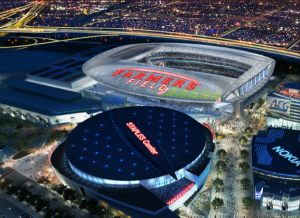 Taking the residents seriously and obeying environmental laws related to compounds as dangerous as perchlorate could have the added benefit of protecting against potential future lawsuits over the missing fireworks data, data that almost certainly involves large amount of perchlorate use. Those lawsuits could target the city and, if successful, end up costing the taxpayers plenty because their government was too cozy with the developer and the media too enfeebled to expose it.
Taking the residents seriously and obeying environmental laws related to compounds as dangerous as perchlorate could have the added benefit of protecting against potential future lawsuits over the missing fireworks data, data that almost certainly involves large amount of perchlorate use. Those lawsuits could target the city and, if successful, end up costing the taxpayers plenty because their government was too cozy with the developer and the media too enfeebled to expose it.
After the unanimous vote late last night, the Times couldn’t help but lampoon community advocates once again with the provocative headline “Anti-poverty group seeks $60 million from NFL stadium developer” making it look like one of the Play Fair Farmers Field coalition members, the Los Angeles Community Action Network, was being insanely greedy. Actually the request was for $2 million a year for 30 years.
AEG claimed to reporter David Zahniser that they could have “had a deal by now” if it had paid the group off its $10 million demand. That below the belt – and inaccurate – accusation seems to indicate AEG’s inclination to perhaps, well, not play fair.
For now, however, activists are still sounding a conciliatory tone.
“You know if the happiest place on Earth can do it, I think AEG can do it,” Argüello says. “I see no reason why they couldn’t, given their commitment to environmental stewardship, or why they wouldn’t be able to get this new technology into their stadium so they can tout their sustainability practices.”
Don’t hold your breath. Until you have to.












Even Phil Anschutz sees his downtown collection of Vegas-type entertainment/sports venues as a liability. So he is selling them. Perhaps LA officials can take a hint.
The best way to do what you want is to just do it. It is easier to apologize than ask for permission. And so it goes with the toxic fireworks. The less said, the better.
No reason then to continue to use this heavy metal in the fireworks as there are alternatives. However, it begs the question; Why do they insist to continue? Well, there is another rabbit hole to go down starting with the word “Agenda”? Thank you Michael for the great article!
Judging from the dearth of media coverage of this amazing discovery, it appears Collins is right about the press (mainstream and otherwise) being too “enfeebled to expose it.” That won’t, however, make the problem go away even if this dirty secret is swept under the football field. The law is the law. If this plan to use who-knows-how-much perchlorate in the fireworks at Farmers Field is pushed through by the Los Angeles city council without coming to a full-stop by requiring AEG to pony up with the toxic numbers, there could be big trouble. Low income (and high income) residents won’t even know about this stealthy perchlorate plan unless the public and community advocates make a stink about it and demand that the fireworks are pollution free. Surely, the money spent actually becoming the environmental leader in fireworks displays and new technology grand entertainment would cost AEG significantly less money than the cost that could face the company when the wafts of perchlorate and heavy metals begin impacting people from the day the place opens. It costs the city council nothing to stand up for the health and well being of the visitors to Farmers Field and the neighborhoods around it by requiring AEG to release the true ingredients (and amounts) in the fireworks and then demanding that the company go back to the drawing board to make sure that they be made harmless. This would make AEG and the city of LA the leaders in ‘green fireworks’ far more than the happiest kingdom on earth which still uses perchlorate yet touts its less smoky pyrotechnics. We deserve no less. The people fighting this fraudulent environmental impact report deserve no less. They must demand these fundamental changes before it is too late.
Another excellent expose’ by Mr. Collins.
This explains why I’ve noticed an increase in particulate pollution in air-quality-animated-maps after holidays/occasions where fireworks were used.
( Each state’s environmental department should have its own animated map that you can google to find, but here’s one for the U.S. — http://airnow.gov/ )
Interesting how the trolls (Scott S. Smith) are always the first to jump on the truth with their ludicrous, vicious, and psychopathic comments. Anyone want to place bets that HE doesn’t live next to the proposed stadium?
@SS Smith: there is a large body of research on the toxicity of heavy metals from exploded fireworks from within the water quality field. As a result of tested, peer-reviewed scientific evidence, many cities (particularly in the Great Lakes region) have already taken steps to change the types of fireworks used or ban them if non-toxic ones aren’t available. Your rhetoric and insults are infantile and aren’t going to bait anyone to respond in kind. Instead, you are providing a platform for a deeper discussion of the scientific soundness behind Michael’s pieces.
If being a ‘red-blooded’ American means ‘symbols’ are more important than the health of children, then please count me out.
I am ‘Earthling’ first!
Borders are imaginary lines.
Every time I read an article on perchlorate use, I’m reminded afresh of how stupid people are. In particular, it’s amazing how anything but profits are ignored by the tools running these large corporations.
@Scott S. Smith – not sure what you are promoting here – if fire works are a symbol of freedom – can’t they also be in a form that would not contain perchlorate and not endanger the health of Americans?
Michael Collins has done a lot of research and given a rational and in depth account of this problem – name calling has no place in an intelligent conversation on how to protect people’s air and water from a dangerous substance.
Thank goodness we have Michael who is willing to take the time and energy to investigate yet another threat to the health of the environment and the American people. Why on earth would anyone “put him in jail”? Michael is doing what very few people are doing – watching out for our environment and telling us about what he finds. We are incredibly fortunate to have him in our lives.
No red-blooded American should stand for regulating fireworks of any color–they’re the symbol of freedom and anarchy is one of the founding principles of this country. I think Collins should be deported to whatever socialist country his ancestors claim to be from and he can argue his pinko theories there, if they don’t put him in jail first.